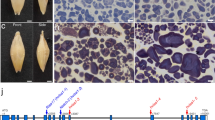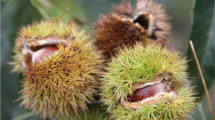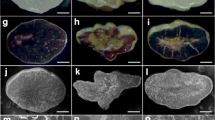Abstract
The wrinkled-seed mutant (rr) of pea (Pisum sativum L.) arose through mutation of the gene encoding starch-branching enzyme isoform I (SBE1) by insertion of a transposon-like element into the coding sequence. Two isoforms of starch-branching enzyme have been documented in the developing pea embryo. The second isoform, SBEII, is expressed towards the later stages of embryo development while SBEI is expressed highly in the early stages. Due to mutation of SBEI the total amount of starch and the proportion of amylopectin, a branched starch polymer, are greatly reduced in the wrinkled (rr) line as compared to that in the wild-type, round (RR) line. Consequently, the level of sucrose in the rr line is nearly two fold that of the RR line. Increased sucrose concentration in the developing embryos of this mutant line causes increased uptake of water and thereby increases the cell size and fresh weight. During seed maturation in these mutant seeds a greater loss of water occurs. As a result, the wrinkled seed phenotype develops. Besides this morphological variation, the mutation also causes changes in the amount of lipid and of one storage protein, legumin. This review article discusses the role of the SBEI enzyme in causing such metabolic changes in the developing embryos with the implication that metabolism can play a central role in plant development.
Similar content being viewed by others
References
Ambrose MJ, Wang TL, Cook SL, Hedley CL: An analysis of seed development in Pisum sativum. IV. Cotyledon cell populations in vivo and in vitro. J exp Bot 38: 1909–1920 (1987).
Bae JM Giroux M, Hannah L: Cloning and characterization of the brittle-2 gene of maize. Maydica 35: 317–322 (1990).
Balceni C, Rizzi E, Motto M, Salamini F, Thompson R: The accumulation of zein polypeptides and zein mRNA in cultured endosperms of maize is modulated by nitrogen supply. Plant J, in press.
Bateson W: Experiments in plant hybridization by Gregor Mendel. J Royal Hort Sci 24: 1–32 (1901).
Bettey M, Smith AM: Nature of the effect of the r locus on the lipid content of embryos of peas (Pisum sativum L.). Planta 180: 420–428 (1990).
Bhattacharrya MK, Smith AM, Ellis THN, Hedley C, Martin C: The wrinkled-seed character of pea described by Mendel is caused by a transposon-like insertion in a gene encoding starch-branching enzyme. Cell 60: 115–122 (1990).
Bhave MR, Lawrence S, Barton C, Hannah LC: Identification and molecular characterization of shrunken-2 cDNA clones of maize. Plant Cell 2: 581–588 (1990).
Boyer CD, Preiss J: Multiple forms of starch branching enzyme of maize: evidence for independent genetic control. Biochem Biophys Res Commun 80: 169–175 (1978).
Boyer CD: Starch granule formation in developing seeds of Pisum sativum L.: effect of genotype. Am J Bot 68: 659–665 (1981).
Dalby A, Tsai CY: Comparisons of lysine and zein and nonzein protein contents in immature and mature maize endosperm mutants. Crop Sci 15: 513–515 (1975).
Darbishire AD: On the result of crossing round and wrinkled peas, with especial reference to their starch-grains. Proc Royal Soc 80: 122–135 (1907).
DiFonzo N, Fornasari E, Gentinetta E, Salamini F, Soave C: Proteins and carbohydrate accumulation in normal, opaque-2 and flowry maizes. In: Miflin B, Zoschte M (ed) Carbohydrate and Protein Synthesis, pp. 199–212. Commission of the European Communities, Brussels (1978).
Doll H, Jensen J, Køie B, Kreis M, Torp J: Studies of barley high-lysine mutants and seed proteins at Risø. In: Induced Mutants for Cereal Grain Protein Improvement, pp. 165–170. International Atomic Energy Agency, Vienna (1982).
Edwards J, ap Rees T: Sucrose partitioning in developing embryos of round and wrinkled varieties of Pisum sativum. Phytochemistry 25: 2027–2032 (1986).
Edwards J, ap Rees T: Metabolism of UDP-glucose by developing embryos of round and wrinkled varieties of Pisum sativum. Phytochemistry 25: 2033–2039 (1986).
Edwards J, Green JH, ap Rees T: Activity of branching enzyme as a cardinal feature of the Ra locus in Pisum sativum. Phytochemistry 27: 1615–1620 (1988).
Ellis THN, Domoney C, Castleton J, Cleary W, Davies DR: Vicilin genes of Pisum. Mol Gen Genet 205: 164–169 (1986).
Gregory RP: The seed characters of Pisum sativum. New Phytol 2: 226–228 (1903).
Hannah LC, Nelson CEJr.: Characterization of ADP-glucose pyrophosphorylase from Shrunken-2 and Brittle-2 mutants of maize. Biochem Genet 14: 547–560 (1976).
Hedley CL, Smith CM, Ambrose MJ, Cook S, Wang TL: An analysis of seed development in Pisum sativum II. The effect of the r-locus on the growth and development of the seed. Ann Bot 58: 371–379 (1986).
Horowitz J: Ultrastructural observations of cotyledons in dry and developing seeds of round and wrinkled lines of Pisum. Micron Microscopia Acta 14: 207–217 (1983).
Hylton CM, Smith AM: The rb mutation of peas causes structural and regulatory changes in ADP glucose pyrophosphorylase from developing embryos. Plant Physiol 99: 1626–1636 (1992).
Kappert H: Untersuchungen on Mark-, Kneifel- und Zuckererbsen und ihren Bastarden. 2. Ind Abst Vererbungslehre 13: 1–15 (1915).
Kooistra E: On the differences between smooth and three types of wrinkled peas. Euphytica 11: 357–373 (1962).
Lamprecht H: Pisum sativum L. oder P. arvense L. eine nomenklatorische Studie auf genetischer Basis. Agric Hort Gen 14: 1–14 (1956).
Matters GL, Boyer CD: Soluble starch synthases and starch branching enzymes from cotyledons of smooth- and wrinkled-seeded lines of Pisum sativum L. Biochem Genet 20: 833–848 (1982).
Mendel G: Versuche über Pflanzen-Hybriden. Verh Naturforsch Ver Brünn 4: 3–47 (1865).
Misra PS, Jambunathan R, Mertz ET, Glover DV, Barbossa HM, McWhister KS: Endosperm protein synthesis in maize mutants with increased lysine content. Science 176: 1425–1427 (1972).
Misra PS, Mertz ET, Glover DV: Studies on corn proteins. VI. Endosperm protein changes in single and double endosperm mutants of maize. Cereal Chem 52: 161–166 (1975).
Nelson OE, Rhines HW: The enzymatic deficiency in the waxy mutant of maize. Biochem Biophys Res Commun 9: 297–300 (1962).
Nelson OE: Genetic control of starch synthesis. In: Hill RD, Munck L (eds) New Approaches to Research on Cereal Carbohydrates. pp 19–28. Elsevier Amsterdam/Oxford/New York/Tokyo (1985).
Rocha-Sosa M, Sonnewald U, Frommer W, Stratmann M, Schell J, Willmitzer L: Both developmental and metabolic signals activate the promoter of a class I patatin gene. EMBO J 8: 23–29 (1989).
Shewry PR, Williamson MS, Kreis M: Effects of mutant genes on the synthesis of storage components in developing barley endosperms. In: Thomas H, Grieson D (eds) Developmental Mutants in Plants, pp. 95–118. Cambridge University Press, Cambridge (1987).
Smith AM, Bettey M, Bedford ID: Evidence that the rb locus alters the starch content of developing pea embryos through an effect on ADP glucose pyrophosphorylase. Plant Physiol 89: 1279–1284 (1989).
Smith AM, Neuhaus HE, Stitt M: The impact of decreased activity of starch-branching enzyme on photosynthetic starch synthesis in leaves of wrinkled-seeded peas. Planta 181: 310–315 (1990).
Smith AM: Major differences in isoforms of starch-branching enzyme between developing embryos of round- and wrinkled-seeded peas (Pisum sativum L.) Planta 175: 270–279 (1988).
Tsai CY, Larkins BA, Glover DV: Interaction of the Opaque-2 gene with starch-forming mutant genes on the synthesis of zein in maize endosperm. Biochem Genet 16: 883–896 (1978).
Turner SR, Barratt DHP, Casey R: The effect of different alleles at the r locus on the synthesis of seed storage proteins in Pisum sativum. Plant Mol Biol 14: 739–803 (1990).
Wang TL, Hadavizideh A, Harwood A, Welham TJ, Harwood WA, Faulks R, Hedley CL: An analysis of seed development in Pisum sativum. XIII. Chemical induction of storage product mutants. Plant Breed 105: 311–320 (1990).
Wang TL, Hedley CL: Seed development in peas: knowing your three ‘r’s (or four, or five). Seed Sci Res 1: 3–14 (1991).
Wang TL, Smith CM, Cook SK, Ambrose MJ, Hedley CL: An analysis of seed development in Pisum sativum III. The relationship between the r locus, the water content and the osmotic potential of seed tissues in vivo and in vitro. Ann Bot 59: 73–80 (1987).
White OE: Studies of inheritance in Pisum. II. The present state of knowledge of heredity and variation in peas. Proc Am Phil Soc 56: 487–588 (1917).
Author information
Authors and Affiliations
Rights and permissions
About this article
Cite this article
Bhattacharyya, M., Martin, C. & Smith, A. The importance of starch biosynthesis in the wrinkled seed shape character of peas studied by Mendel. Plant Mol Biol 22, 525–531 (1993). https://doi.org/10.1007/BF00015981
Received:
Accepted:
Issue Date:
DOI: https://doi.org/10.1007/BF00015981




